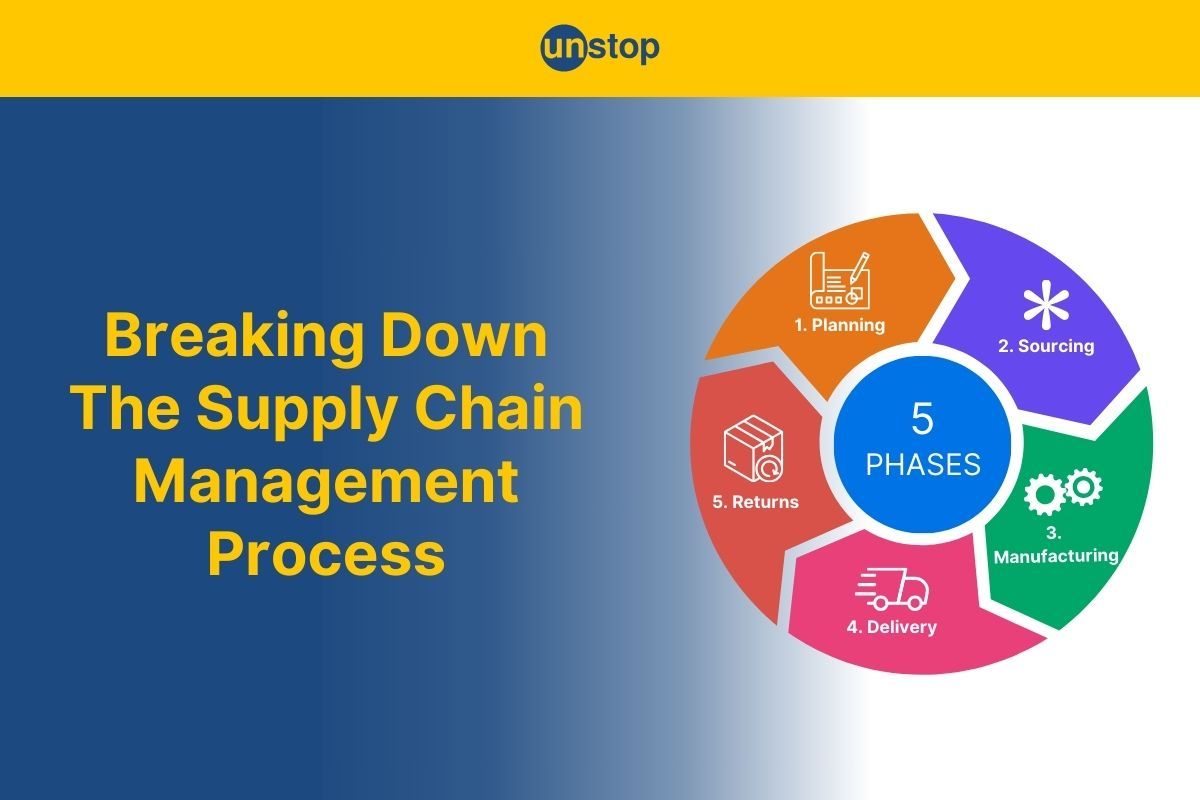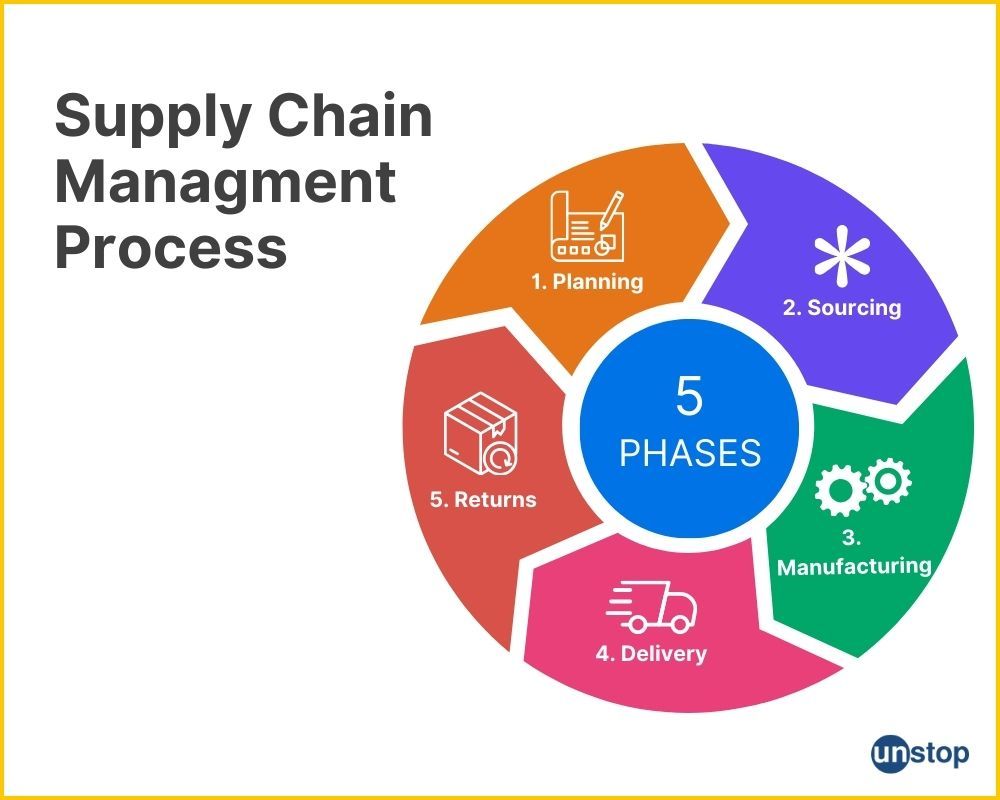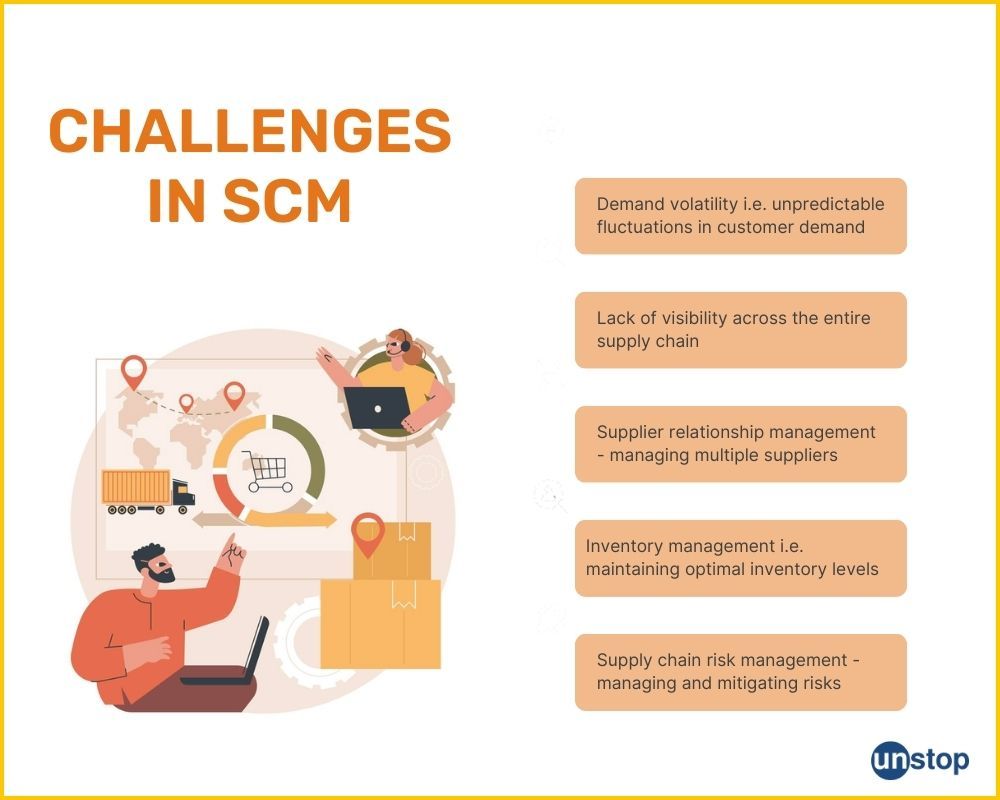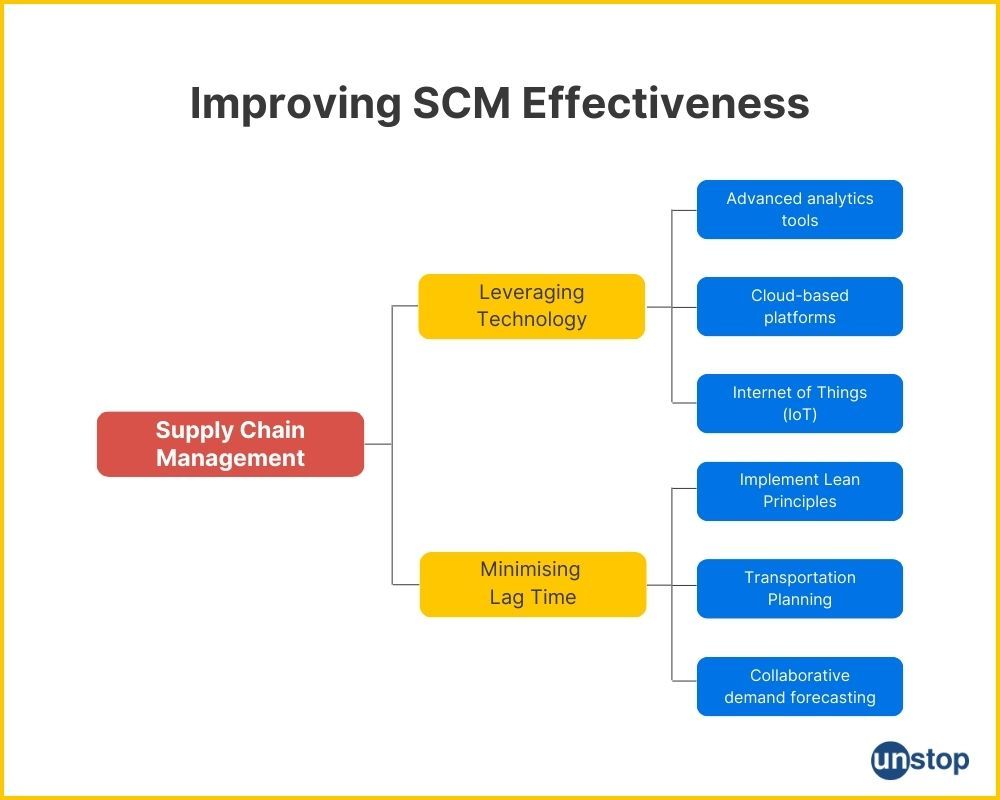- What is Supply Chain Management?
- Why is SCM Important?
- Phases of SCM
- Types and Examples of Supply Chain Models
- Challenges in Supply Chain Management
- Leveraging Technology & Minimizing Lag Time in SCM
- SCM vs ERP: How Are They Different?
- SCM: Jobs & Average Salary
- Frequently Asked Questions (FAQs)
What Is Supply Chain Management, Why Is It Important & How Does It Work?

Have you ever wondered how a product goes from being made to ending up in your hands, i.e., the path from creation to delivery?
Imagine you're craving a delicious slice of pizza. You place an order online from your favorite pizza place. As you wait for the order, a whole process is taking place behind the scenes, ensuring the pizza gets to you. That's where supply chain management (SCM) comes into play.

When you order a pizza, the pizza place needs to plan for the ingredients, source them from suppliers, manufacture the pizza, deliver it to your doorstep, and handle any returns if necessary. SCM ensures that the entire process is carried out efficiently and effectively, ensuring customer satisfaction.
Simply put, it's not just about making and delivering the pizza; it's about ensuring that every step of the way, from sourcing the ingredients to delivering the final product, is done in the most optimized manner possible.
What is Supply Chain Management?
To answer what is supply chain management, let’s see its definition -
Supply chain management (SCM) is the coordination and management of activities that facilitate the flow of goods and services from suppliers to customers. It involves planning, sourcing, manufacturing, delivery, and even returns.
Effective SCM can lead to improved customer satisfaction and increased profitability for businesses. The process involves supply chain managers overseeing logistics, inventory management, procurement, and working closely with suppliers and other supply chain partners. With the rise of global supply chains and complex supply chain networks, the role of supply chain professionals has become crucial in ensuring smooth operations and efficient delivery of products or services.
Why is SCM Important?
Here are the key benefits of effective SCM:
- Timely Delivery: SCM ensures that products are delivered on time, increasing customer satisfaction.
- Improved inventory management: By implementing an SCM system, organizations can better track their inventory levels, reducing the risk of stockouts or excess inventory. This not only saves costs but also ensures that customers' demands are met without delays.
- Better collaboration with suppliers and partners: SCM enables efficient collaboration, leading to faster delivery times and improved overall performance. By working closely with suppliers and partners, organizations can ensure that the right materials are available when needed, avoiding production delays.
- Greater visibility into their supply chain processes: This visibility allows organizations to identify bottlenecks or inefficiencies and make necessary improvements. For example, if a particular supplier consistently causes delays in the delivery process, organizations can address this issue by finding alternative suppliers or negotiating better terms.
Supply Chain Management (SCM), thus, streamlines operations, reduces costs and enhances efficiency to avoid production delays and improve customer satisfaction.
Phases of SCM

Now that we’ve understood what is supply chain management, it’s important to understand its process. The supply chain management process comprises five phases, namely:
Planning
In the planning stage of supply chain management (SCM), companies forecast demand, set goals, develop strategies, and create budgets. It involves analyzing market trends, customer preferences, and historical data to estimate future demand for products or services. By doing so, businesses can determine the quantity of goods to produce or purchase from suppliers.
Sourcing
Sourcing is a crucial step in SCM that involves identifying suppliers, negotiating contracts, managing relationships, and ensuring quality control. Companies need to find reliable suppliers who can provide the necessary raw materials or components at competitive prices. Negotiating favorable terms and conditions helps in securing cost-effective deals while maintaining quality standards. Building strong supplier relationships is essential for smooth operations and timely deliveries.
Manufacturing
The manufacturing phase focuses on transforming raw materials into finished products through efficient production processes. This includes activities such as assembly lines, quality control checks, inventory management, and packaging. Effective manufacturing ensures that goods are produced in a timely manner while minimizing waste and optimizing resources.
Delivery
The fourth phase of supply chain management is delivery. This phase involves the transportation and delivery of products or services to the customers. It includes activities such as order fulfillment, inventory management, and logistics. During the delivery phase, companies need to consider various factors such as transportation costs, delivery speed, and customer preferences.
Returns
The fifth phase of supply chain management is returns. Returns refer to the process of handling and managing product returns from customers. This phase is also known as reverse logistics. Returns can occur due to various reasons such as product defects, customer dissatisfaction, or changes in customer requirements. The phase includes activities like product inspection, refurbishment, disposal, issuance of return authorizations, and processing of refunds or replacements. Managing returns effectively is crucial for companies to minimize costs and maintain customer loyalty.
These phases are integral to the overall supply chain management process. They work together to ensure a smooth flow of goods from initial planning to final delivery. Each stage plays a vital role in maximizing efficiency, reducing costs, and meeting customer demands.
SCM in the Retail & Manufacturing Industry
To better understand what is supply chain management, let's take a closer look at some real-life applications of SCM in different industries:
Retailers
By implementing intelligent SCM software, retailers can effectively manage their inventory and logistics. This helps them anticipate customer demand, optimize stock levels, and minimize out-of-stock situations. For example, a company like Delhivery uses SCM technology to efficiently manage inventory, track shipments, and optimize its delivery network. With real-time visibility into its inventory levels and logistics operations, Delhivery is able to streamline its processes and ensure the timely delivery of goods to customers.
SCM is an integral part of the retail industry. Find out more about the industry in this detailed guide.
Manufacturers
In the manufacturing industry, SCM helps streamline various activities such as procurement, production planning, and distribution. By using SCM software, manufacturers can improve coordination between different departments and suppliers. This ensures that raw materials are procured efficiently, production schedules are optimized, and finished goods are delivered on time. A prime example of this is how companies like Apple implement SCM practices to manage their global supply chain effectively.
Types and Examples of Supply Chain Models
There are different models used in SCM, each with its approach and benefits:
Linear Supply Chain Model
The linear supply chain model follows a sequential flow from suppliers to manufacturers to distributors and finally to retailers. It is a traditional approach that focuses on efficiency and cost reduction. In this model, each participant operates independently, with minimal collaboration or information sharing.
Examples:
- A clothing manufacturer sourcing raw materials from textile suppliers, producing garments in their factories, distributing them through wholesalers or distributors, and selling them in retail stores.
- A food processing company procuring ingredients from farmers, processing them into finished products, distributing them to regional warehouses, and then delivering them to grocery stores.
Networked Supply Chain Model
The networked supply chain model emphasizes collaboration among multiple partners for shared benefits. It involves interconnected relationships between various entities involved in the supply chain. Collaboration is key in this model as participants work together to optimize processes and achieve mutual goals.
Examples:
- An automotive company collaborating with multiple suppliers, logistics providers, and dealerships to streamline production, inventory management, and distribution.
- An e-commerce platform partnering with third-party sellers, fulfillment centers, and delivery services to provide customers with a wide range of products efficiently.
Hybrid Supply Chain Models
Hybrid supply chain models combine elements of both linear and networked models for customized solutions. They offer flexibility by incorporating different approaches based on specific business requirements.
Examples:
- A pharmaceutical company adopting a hybrid model by manufacturing some drugs internally while outsourcing the production of others to specialized contract manufacturers.
- A technology company using its own distribution centers for certain products but relying on drop-shipping arrangements for others.
Challenges in Supply Chain Management

To thoroughly understand what is supply chain management, it’s important to get an idea bout the major challenges in the process:
- Demand volatility: One of the major challenges in supply chain management is dealing with demand volatility, which refers to the unpredictable fluctuations in customer demand for products or services. This can make it difficult for companies to accurately forecast demand and plan their production and inventory levels. For example, a clothing retailer may experience sudden spikes in demand for certain fashion trends, leading to shortages or excess inventory if not managed effectively.
- Lack of visibility: Lack of visibility across the supply chain is another common challenge. Many companies struggle to track the movement of goods and materials from suppliers to customers, resulting in delays, inefficiencies, and increased costs. For instance, a manufacturer may have difficulty monitoring the location and status of raw materials during transportation, leading to disruptions in production.
- Supplier relationship management: Building and maintaining strong relationships with suppliers is essential for a smooth supply chain. However, managing multiple suppliers can be challenging, especially when they are located in different regions or countries. Companies may face issues such as poor communication, quality control problems, or supplier capacity constraints. For example, an electronics manufacturer may struggle to coordinate with suppliers in different countries, leading to delays in sourcing components.
- Inventory management: Effective inventory management is crucial to balance supply and demand. However, maintaining optimal inventory levels can be challenging, especially when dealing with a wide range of products or seasonal demand fluctuations. Companies need to strike a balance between carrying enough inventory to meet customer demand and minimizing holding costs. For instance, a grocery retailer may struggle to manage perishable goods and avoid excessive waste or stockouts.
- Supply chain risk management: Supply chains are vulnerable to various risks, including natural disasters, geopolitical events, economic downturns, or transportation disruptions. Managing and mitigating these risks is a critical challenge for supply chain managers. Companies need to develop contingency plans, diversify suppliers, and invest in technologies that enhance supply chain resilience. For example, a global manufacturer may face challenges in ensuring business continuity during a pandemic, requiring them to find alternative suppliers or adjust
Leveraging Technology & Minimizing Lag Time in SCM

Leveraging technology in SCM
In today's fast-paced market, it’s not about asking what is supply chain management, but rather how can it be utilized to gain a competitive advantage. One way to do so is by leveraging technology.
Here’s a brief look at how companies can leverage technology in SCM:
Advanced Analytics Tools for Proactive Decision-Making
Advanced analytics tools play a crucial role in supply chain management, providing real-time data insights that empower businesses to make proactive decisions. By leveraging these tools, companies can analyze vast amounts of data to identify trends, patterns, and potential bottlenecks. For example, they can monitor inventory levels, demand forecasts, and supplier performance to optimize their operations and reduce costs. With access to such valuable information, companies can make informed decisions to improve their supply chain efficiency.
Cloud-Based Platforms for Seamless Communication Across Time Zones
In today's globalized world, effective communication between partners across different time zones is essential for successful supply chain management. Cloud-based platforms offer a solution by enabling seamless collaboration and information sharing among global partners. These platforms provide a centralized hub where stakeholders can access real-time updates on inventory levels, shipment statuses, and production schedules. This accessibility fosters better coordination between suppliers, manufacturers, distributors, and retailers.
Find out more about cloud computing applications here.
Internet of Things (IoT) Devices for Enhanced Visibility
The Internet of Things (IoT) has revolutionized supply chain management by offering enhanced visibility at every stage of the process. IoT devices such as sensors and trackers enable businesses to track shipments in real-time. From monitoring temperature conditions during transportation to tracking delivery routes or even detecting potential theft or damage - IoT devices provide valuable insights that help ensure product quality and timely delivery.
They can streamline operations, reduce costs through improved efficiency, strengthen relationships with partners through effective communication channels while ensuring high-quality products reach customers on time.
Minimizing Lag Time in the Supply Chain
One of the key focus areas of supply chain management is minimizing lag time. Lag time refers to the delay or waiting period that occurs between different stages or activities in the supply chain process.
Let’s understand some commonly used approaches that help optimize the SCM process to reduce lag time.
Implementing Lean Principles
One way to minimize lag time is by implementing lean principles, such as just-in-time inventory management. This approach ensures that products are delivered at the right time, reducing the need for excessive storage and associated costs. By closely aligning production with customer demand, companies can streamline their processes and eliminate unnecessary waiting times.
Efficient Transportation Planning
Efficient transportation planning is crucial for minimizing delays in product distribution. By optimizing shipping routes, consolidating shipments, and utilizing advanced tracking technologies, businesses can enhance delivery efficiency while reducing shipping costs.
Collaborative Forecasting and Demand Planning
Collaborative forecasting and demand planning play a vital role in preventing supply chain disruptions. By working closely with suppliers, retailers, and other partners in the supply chain, businesses can gather valuable insights into market trends and customer demands and proactively adjust their production schedules or make necessary inventory adjustments to promptly meet changing demands.
By embracing these strategies, businesses can enhance delivery speed while maintaining cost-effectiveness.
SCM vs ERP: How Are They Different?
It’s not enough to just know what is supply chain management. We also need to understand how it differs from another crucial business management system - ERP, or Enterprise Resource Planning.
ERP Systems
ERP systems focus on integrating various business functions within an organization. These systems help streamline internal processes by consolidating data from different departments like finance, human resources, and inventory management. The goal is to enhance efficiency and provide a centralized platform for managing all aspects of a company's operations.
SCM vs ERP: Extending Beyond Organizational Boundaries
While ERP covers internal processes, SCM extends beyond organizational boundaries to include suppliers, manufacturers, distributors, and customers. It focuses on optimizing the entire supply chain network by improving collaboration among these different entities. The aim is to minimize delays, reduce costs, and enhance customer satisfaction through effective coordination.
SCM: Jobs & Average Salary
Supply chain management (SCM) offers a wide range of career opportunities with various job titles. Some common roles in SCM include supply chain manager, logistics coordinator, procurement specialist, and demand planner. These professionals play crucial roles in ensuring the smooth flow of goods and services from suppliers to customers.
Average Salary Range
Salaries in SCM can vary based on several factors. One significant factor is the level of experience. Entry-level positions may offer lower salaries compared to more senior roles. Other factors that influence salary include the industry sector, geographic location, and specific job responsibilities.
Thus, while the current average salary range for a supply chain manager in India is INR 13-18 L.P.A, these figures are subject to change over time due to market conditions and other external factors. Individuals with advanced degrees or certifications in supply chain management may have higher earning potential.
Conclusion
To stay ahead in today's dynamic business landscape, it is essential for companies to continuously adapt and optimize their supply chains. By embracing innovative technologies, such as advanced analytics tools, organizations can gain better insights into their operations and make data-driven decisions.
Frequently Asked Questions (FAQs)
1. How does supply chain management impact business performance?
Supply chain management plays a critical role in enhancing business performance by optimizing processes across the entire value chain. It helps minimize costs, improve operational efficiency, reduce lead times, enhance product quality control, and boost customer satisfaction levels through faster delivery times, and improved inventory management.
2. What are some common challenges faced in supply chain management?
Some common challenges faced in supply chain management include demand variability, inventory optimization issues, supplier relationship management difficulties, transportation delays or disruptions, and lack of visibility across the supply network due to siloed information systems.
3. How can technology be leveraged for better visibility in supply chains?
Technology can be leveraged for better visibility in supply chains through the use of advanced analytics, real-time tracking systems, and integrated data platforms. These tools enable organizations to monitor inventory levels, track shipments, identify bottlenecks, and gain insights into supplier performance, ultimately improving overall supply chain visibility.
4. What are the key benefits of implementing supply chain models?
Implementing supply chain models brings several benefits to organizations, including improved efficiency and productivity, reduced costs through optimized inventory management and transportation logistics, and enhanced customer satisfaction by ensuring on-time delivery and product availability.
5. How does globalization impact supply chain management?
Globalization has a significant impact on supply chain management as it introduces complexities related to international trade regulations, cultural differences, longer lead times due to distance, and increased reliance on global suppliers. Effective globalization strategies require careful planning and coordination to ensure smooth operations across borders.
You may also be interested in the following:
- Law Of Supply And Demand: Principle, Factor & Example Explained
- Types Of Economic Systems Defined & Explained With Examples
- Consumer Behaviour: Definition, Factors, Models & Methods
- What Is Demand Forecasting, Benefits & Methods Explained
- What Is Demand? Law, Determinants & Types Of Demand Explained
I’m a reader first and a writer second, constantly diving into the world of content. If I’m not writing or reading, I like watching movies and dreaming of a life by the beach.
Login to continue reading
And access exclusive content, personalized recommendations, and career-boosting opportunities.
Subscribe
to our newsletter
















Comments
Add comment